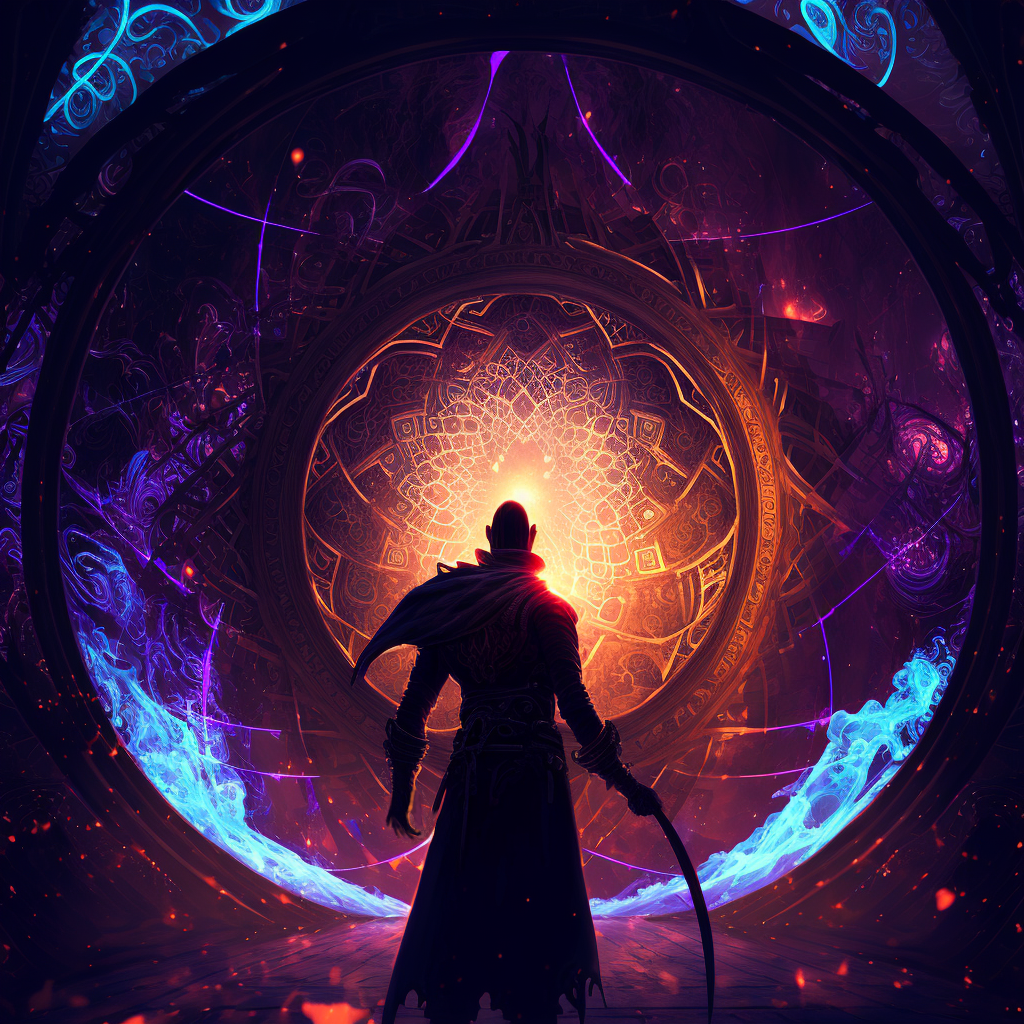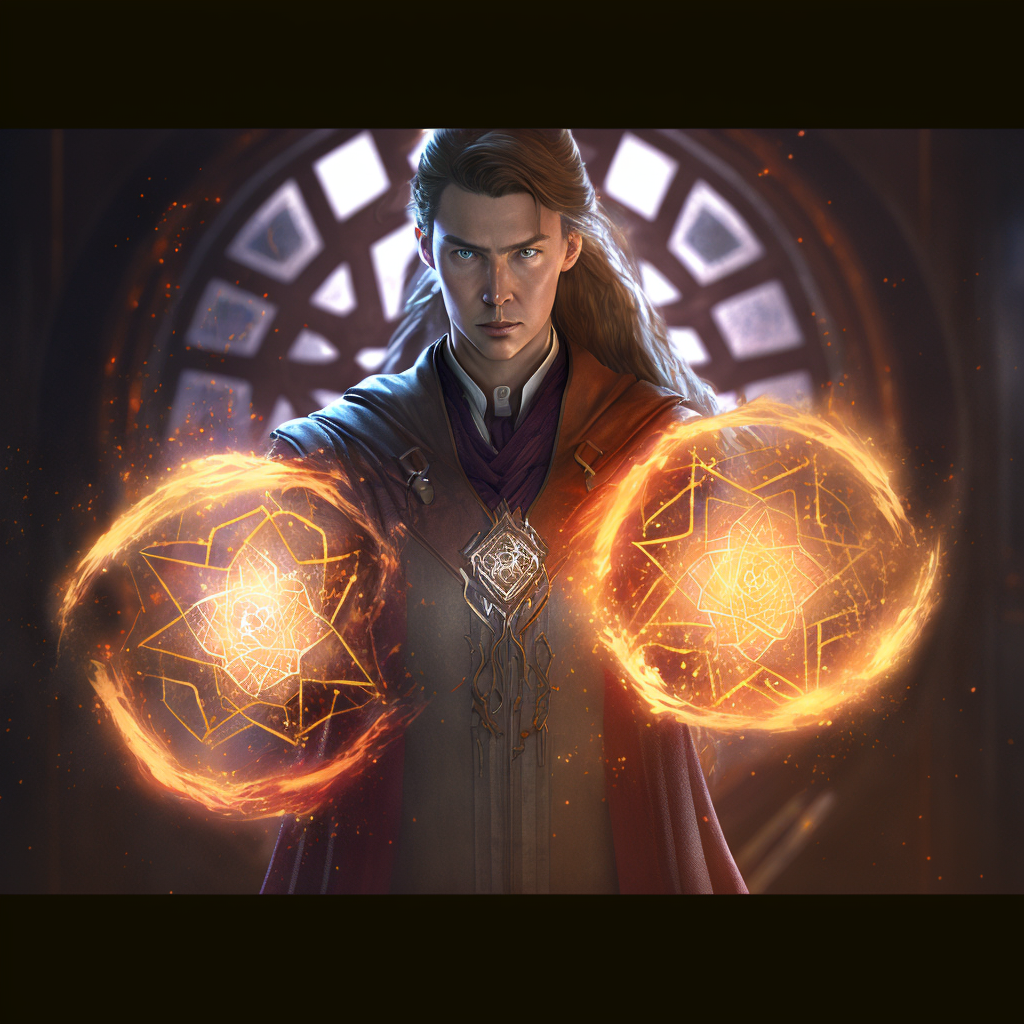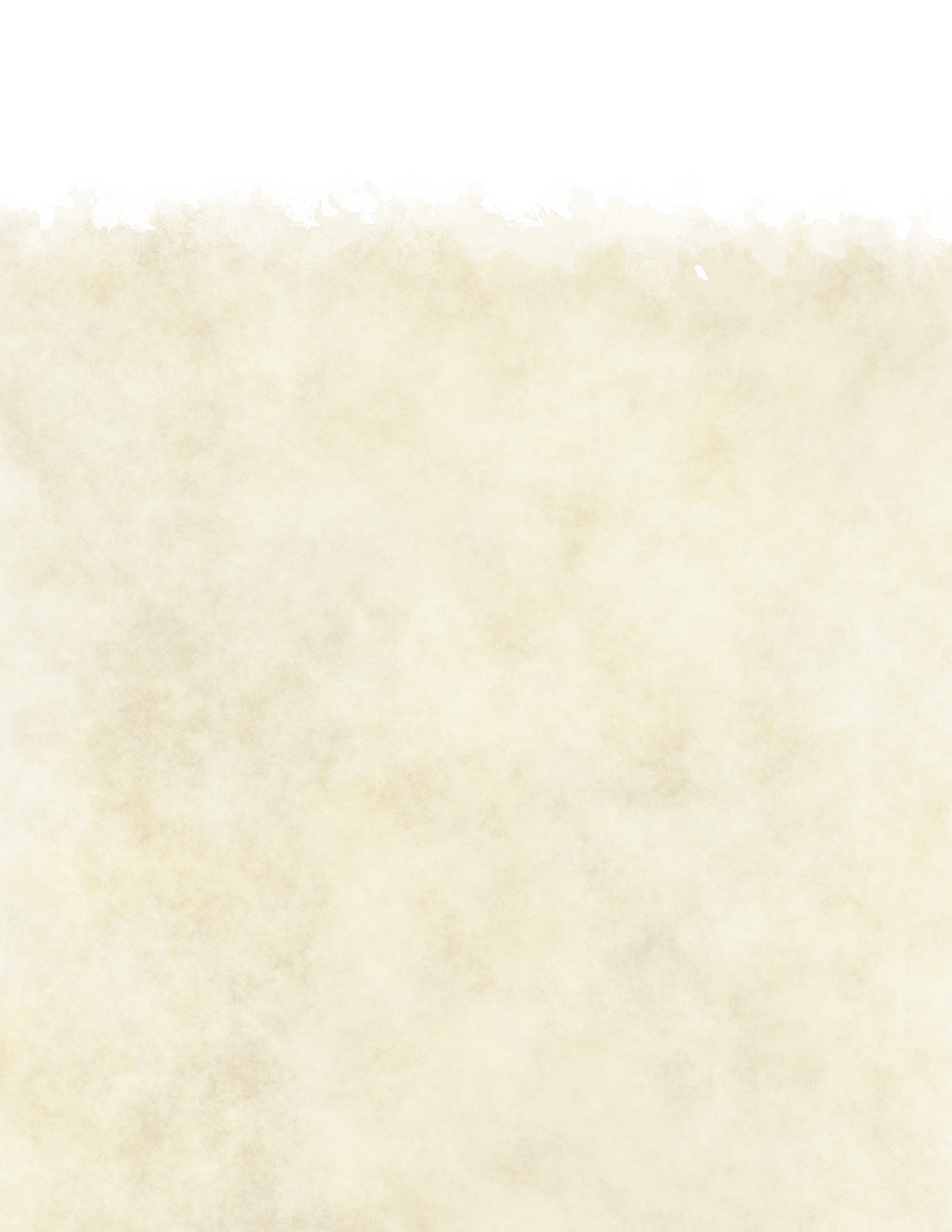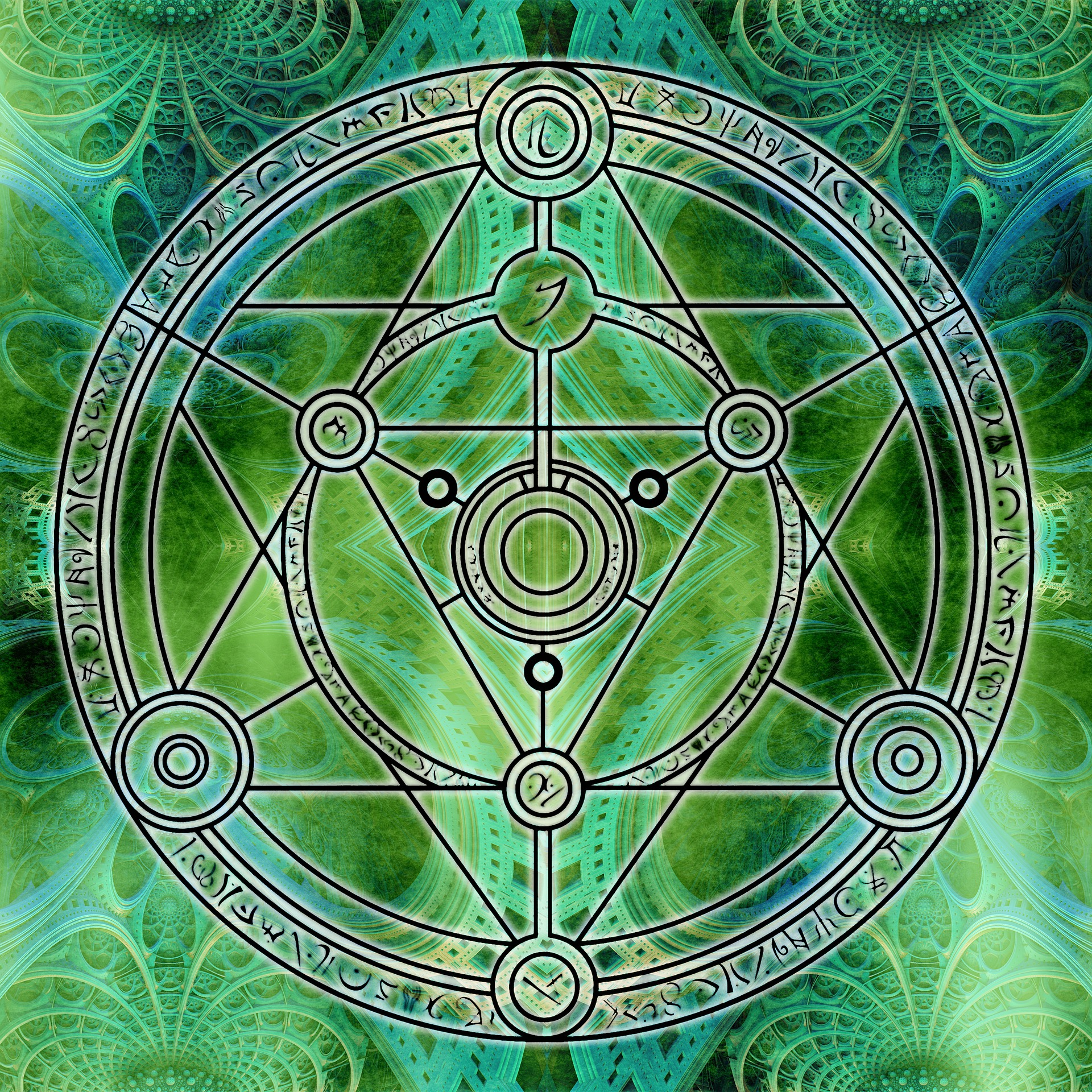


Wizard Class:
School of Symbols
The Sigilist
Pursued by a relentless horde of undead, your team finally reaches a cave. But there is no way out. This shelter is not your home, and the vampires know it. You cannot forbid them.
The cave is about to become your tomb.
With only moments before the thralls and vampire spawn turn you and your friends into a feast, you raise your arm at the entrance and conjure a spectral rune in mid-air. The powerful sigil of allegiance casts a radiant glow. The few undead that dare venture into the warding light retreat with shrieks of pain, grasping their heads as the sigil assaults their minds.
This is your home now. Only allies may enter.
Holding one arm out to maintain the sigil, you aim your hand to floor of the entrance and project an illusory glyph, reproducing the complex pattern from your spellbook in exquisite detail. Then your acid spray cantrip blasts out from the glyph, etching the stone in a perfect replica of the pattern. You have completed hours of rune scribing in mere seconds.
You drop the sigil and empower the more powerful glyph on the floor, upcasting the spell to enhance its duration. It will last the night. And so will you and your friends. By then the sun will be up and you can make your escape.
In the morning, you finally make your way into the long-lost temple, passing traps and clearing vermin with ease. Only when you reach the altar bearing the treasure you seek, does the enemy strike. Dozens of goblins pour into the hall, screeching as they clamber towards you.
"Hold them off! I've almost worked out the enchantment binding this," your team's cleric calls. Again, you raise your arm, tracing the sigil of allegiance yet again. The unwelcome creatures cannot pass, but their arrows can.
As a hail of arrows rains down, you raise your other arm and trace the sigil of ballistics warding, empowering it in a second blaze of light.
The arrows slow, as if caught in molasses, and fall short of their targets.
As your cleric finishes dispelling the curse and raises the prize, he turns to see twenty arrows lying just behind his back. "Cutting it a little close, don't you think?"
"Move!" you call. "I can't keep this up forever." The team retreats into a secret tunnel. You give them as much time as you can, but your sigils are flickering now. Pushing one last surge of magic into the runes, you break your concentration and dash for the tunnel.
Your persistent sigils hold on for another few seconds—a trick no other wizard can match—as you begin casting invisibility on your self. You vanish and dash into the tunnel, just as the sigil shatters.
The enemies pour into the vault, finding nothing.
Welcome to the School of Symbols, where you learn the secrets of conjuring instantaneous wards in mid-air. You learn to cast the illusory image of a complex glyph and burn or etch that sigil or glyph into a surface, saving hours of tedious calligraphy or chiseling. Your research into master glyphs allows you to programming interacting spell effects. And your spell stabilizing rune patterns that allow you to combine your spell power with other casters, amplifying spell effects beyond what other wizards of your level can produce to truly terrifying levels of power.
It is no wonder your reputation precedes you.
You are the sigilist.
Sections
- School of Symbols Features
- Sigils and Wards
- Glyphs and Formations
- Sigilist NPCs and enemies



Symbol Savant
3rd level school of symbols feature
You gain the ability to spend a spell slot to project an illusory glyph of spell from from your spellbook onto a surface. On a subsequent turn you can cast a cantrip through glyph to transfer the pattern. For instance you can use fire bolt or burning hands to burn a rune symbol into wood, or acid spray to etch metal or stone. Range is 10 ft.
The glyph's spell is active on the turn it is completed and the range and area of effect are determined by the spell the glyph represents.
This legendary secret of the school of symbols reduces the time required to create a glyph pattern from hours down to two actions. As described below in the "Glyphs and Formations" section, glyphs allow casters to concentrate longer on spells and even share concentration.
Sigils and Glyphs
3rd level sigilist feature
You learn the sigils of allegiance, ballistics warding, elemental warding, and magic warding.
You also learn the entry glyph, and how to create spell amplification glyphs for spells in your spellbook.
Flourishes
3rd level sigilist feature
Over time, you develop sigilist flourishes (like warlock evocations) that enhance the power of your conjured warding sigils. You may add one sigil flourish to each sigil you create.
Choose two flourishes to learn at 3rd level, and two additional flourishes at 6th, 10th, and 14th levels.
See the Sigil Flourishes section for available flourishes and descriptions.
Double Focus
6th level school of symbols feature
As an accomplished sigilist, you can add up to two flourishes to your sigils. Additionally, you have advantage on checks to maintain concentration on your sigils and wards.
Sigil Expert
10th level school of symbols feature
At 10th level, you can add up to three flourishes to your sigils.
Universal Sigilist
14th level school of symbols feature
At 14th level, your sigil of elemental warding wards against all elemental types and your sigil of magic warding wards magic from all magic schools.
Sigils and Wards
Warding Sigil
1st level abjuration spell
As an action on your turn, you trace a rune in the air and imbue it with arcane magic. The conjured sigil remains in the air, glowing dimly and wards a specified creature or effect from an area. The sigil remains for the duration as long as the caster maintains concentration, unless canceled by dispel magic or a similar antimagic effect.
Casting time: 1 action (can also be cast as a glyph using Symbol Savant using 2 actions)
Duration: 1 minute (concentration)
Components: somatic, material (varies by type)
Range: 5 ft cube around self plus 15 ft. cone
Damage: creatures warded by the sigil must make a Wisdom saving throw when attempting to enter and at the beginning of any turn in the warded area, suffering 2d6 psychic damage on a fail.



Higher levels: Choose one of the following upcasting effects.
- Increase damage: +1d6 additional damage for every level the spell is upcast
- Increase spell DC: increase spell DC by the number of levels the spell is upcast
- Increase the spell area: widen cone to 180 degrees for 1 level upcasting, or to a sphere for two levels. Warded sphere radius doubles successively for each level of upcasting beyond that.
Sigil save DC upcasting example
A wizard with intelligence 18 (+4 modifier) and proficiency bonus 3 casts sigil of allegiance at 3rd levelF (2 levels of upcasting). An enemy creature must make a Wisdom saving throw with a target DC of 8 + 4 + 3 + 2 = 17.
Warding Sigil Types
When casting warding sigil, choose one of the following warding sigil types:
Sigil of Allegiance
Materials: a friendship bracelet or locket
To enter the warded area, a creature must speak a password or succeed on a wisdom saving throw. A correct password is audible only to the caster.
Caster may use their reaction to allow one or more creatures to enter the warded area who do not know the password.
Sigil of Ballistics Warding
Materials: a piece of a broken shield
Attack rolls from ranged weapons or magical
attacks carried by material objects such as a
flaming arrow suffer disadvantage when
passing into or through the warded area.
Similarly, creatures targeted by ranged
attacks from material objects that
require a saving throw, such as a
net or explosive, have advantage
on the saving throw, if the object
passes into or through the
warded area.
Sigil of Elemental Warding
Materials: a piece of wood struck by lightning Wards against attacks causing one specified elemental damage type: lightning, thunder, cold, fire, poison, or acid. Either imposes disadvantage on an effect passing into or through the warded area or grants advantage to creatures making a saving throw when the elemental attack passes into or through the warded area.
Sigil of Magic warding
Materials: a blood-stained piece of a mage's clothing
For spells of a school of magic you specify (evocation, enchantment, divination, conjuration, transmutation, abjuration, illusion, necromancy, or psychic) where the line of sight of the caster and the target is interrupted by the ward area, spell attack rolls have disadvantage and creatures making saving throws against the spell's effects have advantage.
If a creature is concentrating on spell of the warded school of magic and attempts to enter the warded area, they must make a concentration check against your spell DC.
Innately cast spells that are subject to concentration are similarly warded. Magical abilities that are not spells of a specified magical school with concentration are not warded.



Sigil Flourishes
Alert Sigil
When a creature succeeds on a saving throw to enter or remain in the sigil, you are alerted and can use your reaction to make a cantrip attack.
Brilliant Sigil
Creatures with vision and without blindsight successfully entering the warded area or starting their turn in the ward area make a Dexterity saving throw against your spell DC or be blinded for 1 round.
Elemental Sigil
When you create your sigil, you can alter the damage type from psychic to the elemental damage type of your choice: acid, cold, fire, lightning, poison or thunder.
Enthralling Sigil
Prerequisite: casting at 2nd level or higher
Warded creatures that attempt to enter the warded area and fail their saving throw suffer the charmed condition. They remain enchanted as long as they are in the warded area. Enthralled creatures make an additional saving throw at the beginning of their turns.
Faerie Fire Sigil
Warded creatures that fail their saving throw are illuminated with a colored outline, revealing any invisible creatures and granting advantage to the attack rolls against them while the sigil is active.
Faint Sigil
The sigil is invisible.
Inclusive Sigil
For sigils that require choosing an elemental type or magic school you can choose two types/schools.
Persistent Sigil
Unless you choose to dispel them completely, your sigils endure for one round after you stop concentrating on them.
Pivoting Sigil
As a bonus action on your turn you can change the direction your sigil faces.
Projected Sigil
You can create and concentrate on sigils up to a range of 30 ft. away from you.
Solar Sigil
The light of your sigil within the warded area has the properties of sunlight against creatures with sunlight sensitivity.
Terrifying Sigil
Prerequisite: casting at 2nd level or higher
Warded creatures that attempt to enter the warded area and fail their saving throw suffer the frightened condition while the sigil is visible and may attempt an additional saving throw at the end of each of their turns.
Wrathful Sigil
When a warded creature succeeds on a saving throw and enters into or remains in the warded area, you can use your reaction to make an attack by collapsing all the sigil’s energy onto the target. On a hit, the creature takes 3d6 psychic damage per spell level. The sigil spell and warding effects ends with the attack.
Vigilant sigil
Your sigil duration is increaesed to 10 minutes.
Entry Glyph
1st level spell
- Sigilist casting time: 2 actions (form glyph; transfer pattern)
- Components: verbal, somatic
- Duration: concentration, plus one or more duration levels for upcasting or over-exertion
- Range: 10 ft., one entry (door, window, archway, portal, etc.)
Purpose: Wards an entry such as a door, window, archway or portal using one specified warding sigils type.
Once all entries have been warded, the entire structure becomes warded.
Upon attempting to enter the warded area or at the beginning of a turn in the warded area, warded creatures must make a Wisdom saving throw, pitting their will against the sigil’s.
Glyphs and Formations
Glyphs are physical symbols etched or drawn on a surface. Several types exist.
Temporary glyph (concentration)
(The entry glyph is an example of this type.)
Charged to provide a temporary warding effect by a concentrating caster, a temporary glyph activates the moment the charging begins and continues until the caster stops concentrating. A key difference between the glyph and the sigil is that the concentration time can be up to 8 hrs for a physical glyph, whereas a conjured sigil lasts only 1 minute (or up to 10 minutes with the vigilant sigil flourish).
Longer durations than concentration can be achieved by either over-exertion or upcasting. Durations increase in standard increments: 1 min, 10 min, 1 hr, 8 hr, 24 hr, etc.
Upcasting for longer duration example
| Concentration/ charging time at 3rd level | Duration of 3rd level spell effect | Duration of 2nd level spell effect | Duration of 1st level spell effect |
|---|---|---|---|
| 1 min | 1min | 10 min | 1 hr |
| 10 min | 10 min | 1 hr | 8 hr |
| 1 hr | 1 hr | 8 hrs | 24 hrs |
| 8 hrs | 8 hrs | 24 hrs | 1 tenday |
Over-exertion Charging
If a caster does not have higher level spell slots available, the caster can attempt to over-exert themselves to increase the duration of a temporary glyph. For example, a caster can over-exert themselves for 10 minutes to make a symbol active for 1 hour.
After this, the caster must make a DC 12 Constitution save or suffer one level of exhaustion. If a caster attempts to increase a spell’s duration by two levels, they automatically suffer one level of exhaustion and make a DC 12 Constitution saving throw or suffer a second level of exhaustion.
| Concentration time | Spell duration (normal) | Spell duration (0-1 levels of exhaustion) | Spell duration (1-2 levels of exhaustion) |
|---|---|---|---|
| 1 min | 1 min | 10 min | 1 hr |
| 10 min | 10 min | 1 hr | 8 hrs |
| 1 hr | 1 hr | 8 hrs | 24 hrs |
| 8 hrs | 8 hrs | 24 hrs | 1 tenday |
Focus glyph
A focus glyph is created to stabilize a spell for addition of power by multiple casters.
- Spell amplification: When another caster (does not need to know the spell) spends a spell slot and joins concentration, according to the glyph design, the spell damage increases by an amount appropriate to the level of spell slot added, or else increases the spell DC, duration, or else the range or area of effect increments. The amount of increase is determined by the DM.
Spell amplification example
The sigilist uses an action to form an illusory glyph of the spell fireball and declares it is designed for amplifying the spell's effective radius. On the sigilist's next turn they cast a cantrip to etch or burn the glyph. An ally bard ahead of the sigilist in the initiative order readies an action to spend a 2nd level spell slot and channel energy into the glyph when the sigilist casts the spell fireball. On the sigilist's third turn, they cast fireball. The DM rules their combined spell powers increase the area from a 20 ft. radius sphere to a 30 ft. radius sphere.
If the sigilist is ahead of the bard in the initiative order they ready an action to cast the spell when the bard joins and the spell is cast on the bard's turn.
- Concentration sharing: if a caster spends a spell slot on the focus symbol, that caster may add their concentration or take over such that spell does not drop if one caster loses concentration. At any time the sum of the maximum spell levels of casters concentrating must equal or exceed the level of the spell. A caster must be within 10 ft. of the glyph to maintain concentration on the glyph.
Concentration Sharing Example
A sigilist under heavy fire prepares a glyph of the 2nd level spell web in line of sight of a horde of foes and casts it to slow their approach, and allow the team's fighter and barbarian to face the enemies a few at a time. A cleric with heavy armor and a shield joins the concentration by spending a 2nd level spell slot. The sigilist can now drop concentration and prepare an offensive spell, as the high HP cleric maintains concentration from a defensible position.
Chargeable glyph: one-time use
(Example: glyph of warding spell.)
A chargeable glyph can be charged instantly, but it requires dedicating or consuming an object with sufficient value (capacity) to hold a spell. See the guidelines in Common Sense Rules for Making Magical Items.
A single use chargeable glyph can have value of only 1/10th of the standard value for a stable magical item. For example a 50 gp gem has sufficient value to creature capacity to stably hold a 1st level spell charge. This doubles for every spell level, so a fourth level spell requires object of capacity equal to at least 400 gp.
For a maximally over-charged, single-use glyph, the minimum capacity value is 5 gp for a 1st level spell and 40 gp for a 4th level spell.
However, it takes time under the "polarizing" influence of magic to create enough affinity for the spell to want to "stick." As explained in the common sense rules, affinity is accumulated for each spell cast using the gem as a focus, multiplied by 2x for 1 minute concentration, 3x for 10 minutes concentration, or 4x for 1 hour concentration. For one-time use, the item of value must be used as an arcane focus to accumulate at least 1/10th of the affinity for a self-charging item, in this case 10 affinity points per spell level.
As an example, if the object is used as a focus for a level 3 spell under concentration for 1 hr, 3 x 4 = 12 affinity points are accumulated, which is sufficient to hold a level one spell in a single use glyph (namely affinity is >10).
If the affinity is lacking, it can be compensated with more value, as is done in the glyph of warding spell, where the insufficient affinity accumulated in the casting time (3 x 4 = 12 which is less than 300/10 = 30). In this case, the spell cost is 250 gp of diamond dust, which "overcompensates." The general solution of "throw money at it" works. However, if caster were to use an arcane focus with sufficient affinity, or a lower level spell effect, the cost of the glyph of warding would be much lower.
Glyph modes of operation:
Chargeable spell glyphs can be activated in several ways.
Cast on trigger
A glyph can use its reaction to activate an imbued spell when the specified condition is met, such as an object or creature in range, a command word, or a timer expiration.
Initiate timer
A glyph can use its reaction to start a timer. The timer requires an object that the spell consumes as a timer, such as a wick or parchment to burn, a gem or diamond dust to disintegrate, sand in an hourglass, liquid to boil, bubble or evaporate, etc., or a clockwork timer. When the timer is expired a glyph triggers the embedded spell. A master glyph can send a trigger, dispel, arm or disarm signal.
Master trigger
As a bonus action, a master glyph can transmit a signal that will activate a spell in one or more other (slave) glyphs.
Master Dispel
A master glyph can be set to send a signal when triggered that will cancel the ongoing spell of one or more other (slave) glyphs.
Master arm
When triggered the master glyph will allow one ore more other (slave) glyphs to be triggered by their programmed trigger. Prior to the master's arm signal, the glyphs cannot be activated/triggered.
Master disarm
When triggered the master glyph will prevent one or more other (slave) glyphs from being activated/triggered.
Permanent glyph
A glyph provided with sufficient capacity and affinity, can maintain a magical effect such as warding or an illusion indefinitely. The spell range and effects can be reduced to increase the duration of the spell, as explained in the common sense rules.
Master glyph
Integrates and controls multiple spell glyphs. Master glyphs do not contain spell power, but can direct it and thus do not require additional value (capacity) or items with affinity.
Boundary Formation
A boundary formation is made up of several "monoliths" onto which glyphs are drawn, etch, or carved. The perimeter of the warded area is defined by the monoliths, up to a 30 ft. radius. Monoliths can be trees, walls, or stones of 3 ft. height.
Major formation
A major formation is made up of a collection of at least seven large monoliths of 8 ft. height or more. The warded radius is 1 mile. The creation and precise placement of each monolith takes at least one day, with assistance from skilled laborers.
Dispelling, Reactivating and Destroying Symbols
Dispelling
The magical effect of an active symbol can be eliminated by the caster canceling the spell, or another caster using dispel magic, or by destroying the symbol. Conjured sigils cannot be attacked directly, rather the magician must be targeted in an attempt to break their concentration.
Reactivating
Unless the symbol is destroyed, a deactivated or dispelled permanent glyph can be reactivated by any magic caster by expending a sufficient spell slot.
Destroying symbols
To destroy a symbol in paint or ink, the object on which the symbol is made must be defaced or destroyed or its position altered to destroy its relation to other portions of the symbol, for instance tearing a piece of parchment, chopping down a tree, chiseling through lines of a rune, fracturing or tipping over a stone, etc. Merely painting over a symbol will not affect it, provide the spell has already been imbued or the spell is active.
Large monoliths are chosen for significant formations in part because they have very high HP and are difficult to dislodge.
Partial collapse
In a boundary formation, when a monolith of the formation is destroyed or ruined, the area of protection reduces to the polygon inscribed by the remaining pieces of the formation.
In a major formation, the range of the formation decreases with each fallen pillar by an amount determined by the DM.
Example NPCs/enemies
Sigil Hobbyist
The sigil hobbyist is a low level NPC that can serve as an ally/sidekick for a team that needs a support wizard, or as minion for a work-from-home criminal mastermind end boss.
Sigil Hobbyist 4
stout halfling, neutral
- Armor Class 12
- Hit Points 56 (8d6+24)
- Speed 30 ft.
STR DEX CON INT WIS CHA 8 (-1) 14 (+2) 16 (+3) 16 (+3) 14 (+2) 8 (-1)
- Saving throws Int +5, Wis +4
- Skills Arcana, Investigation, History +5, Survival +4
- Languages Common, Halfling
- Proficiency Bonus +2
- Challenge 2 (450 xp)
- Halfing luck reroll natural 1's
- Small size can move through larger creature's spaces
- Halfing constitution advantage on saves vs. poison, poison resistance
Spells
Cantrips acid splash, mind sliver
1st level spells (4 slots) absorb elements, shield, disguise self, expeditious retreat
2nd level spells (3 slots) misty step, vortex warp, scorching ray, Melf's acid arrow
Warding Sigils allegiance, ballistics warding, magic warding
Sigil Flourishes faerie fire sigil (adv. to hit creatures that fail sigil save for 1 min)
Actions
Dagger +4 to hit, 1d4+2 slashing
Darts (5) +4 to hit, 1d4+2 piercingReactions
Shield 1st level spell, +5 AC to single attack after attack roll
Misty Step 2nd level spell, teleport to space within 60 ft.
Equipment
Potion of healing (1), component pouch, fishing pole, tackle, spell book with sales orders, bills, and tax receipts, 25 gp
Rune Wreckers
The Rune Wreckers are a gang of casters who use glpyhs to combine their spell energies into more powerful spells. When hired for dirty work, they prefer to sneak up on enemies, cast a big damage spell and then run away before they get caught and eaten/slain (or worse).
Rune Wrecker
hobgoblin, neutral evil
Sigil Guru
The Sigil Guru is a mid-level enemy or ally that likes to keep their enemies at comfortable distance. High DC warding sigils make it tough to get close and this guru likes to use the wrathful sigil to punish anyone who does manage to push through their wards.
Sigil Guru
high elf, neutral good
Glyph Coder
The glyph coder programs complex and interacting spell effects using glyphs and is often hired to kit-out a new manor or summer home with spell protections, or to create haunted houses for children's carnivals (or more nefarious purposes). A glyph coder is most dangerous on their home turf. A glyph coder's lair is usually protected by several boundary formations. There is no better contractor for home security, and no worse person to visit while trying to sell pest control services as a summer job.
Glyph Coder
gnome, chaotic neutral




FAQs
- Hemisphere cone sigils – When upcasting a sigil to widen the cone to a 180 degree hemisphere, it can point sideways in any direction, but if it is pointed up to block flying attackers, allow creatures to crawl under it from the sides. Creatures smaller than the caster can approach unimpeded from the sides. Otherwise, it is effectively the same as a sphere.
Contribution Credits
| Type | Source |
|---|---|
| Art | Rune by Pete Linforth, Pixabay noncomercial license |
| Art | Library by Erique Meseguer, Pixabay noncomercial license |
| Art | All other art original creations using Midjourney tool with commercial license. |
Change Log
| Date | Change |
|---|---|
| 2023.05.04 | Added a few clarification from email questions (thanks Stan!) |
| 2022.09.09 | removed reaction shift of pivoting sigil because trigger was not described. Rephrased vigilant sigil. Buffed back to 2 flourishes at 3rd level. |
| 2022.08.26 | Beefed up 6th level feature with advantage on concentration checks because players said it felt "meh" compared to what other players at the table were getting for subclass features at 6th. |
| 2022.04.19 | Nerfed divided mind to be two flourishes, not two separate sigils. At 14th level buffed elemental and magic sigils to not be limited by elemental type or magic school. Renamed ward glyph to entry glyph to avoid confusion with glyph of warding. NPCs work still in progress. |
| 2022.04.15 | removed redundant sigils (allegiance is sufficient to block unwelcome creatures. Fixed concentration sharing example. |
| 2022:03.27 | Added components for sigil of warding |
| 2022.02.22 | Revisions for brevity and examples. |
| 2022.02.21 | Initial draft. All original content. |
Feedback Please!
Have questions, comments, playtest feedback, or requests for additional content or changes? Questions are added to FAQs section. Need more encounters, NPCs, or maps?
Missing attribution?
Broken ability that needs nerfing?
Did you enjoy this supplement?
I need your feedback!
Contact Dan at adventure@authordanallen.com.